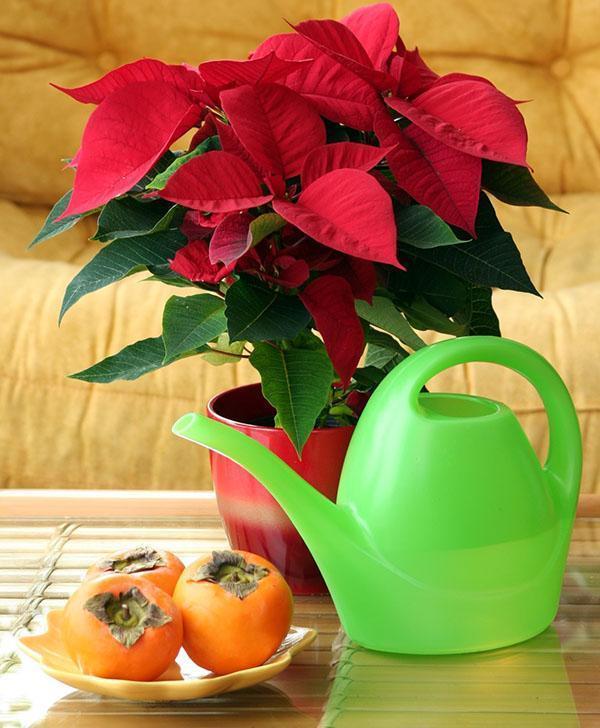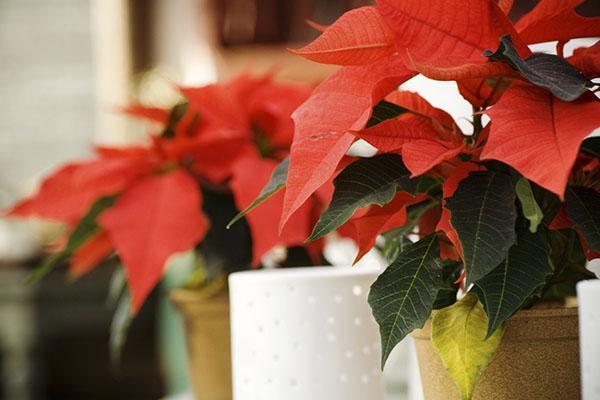Caring for the poinsettia plant at home
 The poinsettia bloom in the middle of winter made it a bright attribute of the New Year and Christmas. As a tropical plant, poinsettia at home requires special care and knowledge by the grower of all its features.
The poinsettia bloom in the middle of winter made it a bright attribute of the New Year and Christmas. As a tropical plant, poinsettia at home requires special care and knowledge by the grower of all its features.
In order for the shrub that withers a month after the celebrations to be covered with leaves again and unfolded decorative bracts, the grower will have to:
- adjust to the natural cycle of flower development;
- provide a green pet with nutritious soil and moisture;
- create optimal temperature conditions;
- find a place for the plant for active growth and a dormant period.
If we neglect this, and also do not provide a dormant period for 9-10 weeks, which is mandatory for poinsettia at home, the faded plant is unlikely to be covered with multi-colored rosettes-stars by next Christmas.
Flower care starts from the moment of purchase. Since a blooming specimen gets into the house, it is not worth replanting immediately. But the careful acclimatization of the poinsettia after purchase will be required.
To do this, the pot is arranged on the west or east window, where there is plenty of light, but there is no risk of sunburn. In 3-4 weeks at a temperature of 18-20 ° C, diffused light and regular moderate watering, the plant will get used to the new habitat, and the florist will be able to make sure that it is healthy and safe for other green inhabitants of the house.
Lighting and location of poinsettia at home
 Poinsettia is a native of the dry tropics and subtropics, which needs a lot of light for comfortable development and flowering. However, sunburn in direct sunlight is dangerous.
Poinsettia is a native of the dry tropics and subtropics, which needs a lot of light for comfortable development and flowering. However, sunburn in direct sunlight is dangerous.
How to choose the location of the poinsettia at home so that the lighting of the flower is optimal:
- It is best to find some meta on the east or west windows. In this case, the peak of illumination occurs in the morning or evening hours, and most of the day, the foliage bask in the diffused, but rather bright light.
- If the pot is inserted on the south side, especially in summer, you cannot do without reliable shading, or at noon you will have to transfer the decorative perennial deep into the room.
- North windows are less suitable than others. Here, the lack of light is felt not only in winter, but also in the warm season, when the growing season is in progress. This means that when caring for a poinsettia, a florist will need special lighting.

Vegetative growth of new shoots on poinsettia begins when the day length reaches 12 hours. In autumn, when there is less light, shoot formation is inhibited, and racemose inflorescences and bright bracts appear on the tops of the stems.
While the flower is at the peak of its decorative effect, from about September to mid-November, regardless of the location, the lighting of the poinsettia at home is reduced to 10 hours. To do this, at night, the bush is covered with an opaque cloth or box, transferred to a dark room.
Temperature range when caring for poinsettia
The poinsettia plant at home reacts equally badly to content at extremely low and high temperatures.
 Staying in a room warmed up to less than +14 ° C threatens:
Staying in a room warmed up to less than +14 ° C threatens:
- pallor and lethargy of the bracts;
- slowdown and arrest of growth;
- a significant decrease in moisture and nutrient intake;
- decay of roots and death.
In the hot season, young shoots droop, foliage may begin to fall. To save the plant, you need to choose a cooler, draft-free place and use regular spraying of the bush with warm soft water.
Therefore, since the end of the dormant period, poinsettia at home is recommended to be kept at 20-22 ° C. The same temperature is desirable for rooting cuttings obtained from the pruning field. From mid-October, when the plant starts laying flower buds, it is useful to reduce the temperature in the room by 2-3 degrees to 17-19 ° C.
Air humidity and watering poinsettia
 Properly organized poinsettia watering and sufficient air humidity are an important part of the success of growing this original plant. If during the dormant period, when growth is practically stopped, the flower almost does not need moisture, then when the buds awaken, the plant can no longer do without watering.
Properly organized poinsettia watering and sufficient air humidity are an important part of the success of growing this original plant. If during the dormant period, when growth is practically stopped, the flower almost does not need moisture, then when the buds awaken, the plant can no longer do without watering.
Irrigation water should be soft, settled, and slightly warmer than the surrounding air. Poinsettia responds to the use of cold moisture by falling foliage, and its roots can rot.
The frequency of watering depends on the condition of the flower and soil, as well as on the temperature and humidity of the air. From spring to the end of flowering, the surface of the substrate should dry out during the time between waterings. If the water that has saturated the soil has passed through and ended up in the pan, it is drained.
In the hot season and in winter, when the room has low air humidity, poinsettia, in addition to watering, must be sprayed or use a home humidifier.
Poinsettia soil and flower feeding regime
 For the active growth of a flower, the soil for poinsettia must be nutritious, loose, moisture and air permeable. The optimum acidity level of the substrate is 5.8–6.6 units.
For the active growth of a flower, the soil for poinsettia must be nutritious, loose, moisture and air permeable. The optimum acidity level of the substrate is 5.8–6.6 units.
If the pH value falls, it affects flower development and causes inhibition of growth, deformation of young leaf blades and less resistance to disease.
As soil for poinsettia, you can take a universal flower soil or make a mixture yourself. To do this, take:
- 3 shares of turf soil;
- 3 pieces of leafy land;
- 1 part cleaned from rough inclusions peat;
- 1 part washed coarse sand.
 Small pieces of charcoal, as well as shredded stalks of dry sphagnum, will be useful in the substrate. Before planting a flower, the resulting soil is disinfected and saturated with prolonged-release fertilizers.
Small pieces of charcoal, as well as shredded stalks of dry sphagnum, will be useful in the substrate. Before planting a flower, the resulting soil is disinfected and saturated with prolonged-release fertilizers.
At home, poinsettia must be fed, paying special attention to microelements, which are introduced in the traditional and foliar way from spring to late autumn, until the growing season ends.
To maintain the brightness of the foliage, complex compounds containing iron, potassium and sulfur, zinc and molybdenum are used. The first fertilization is carried out 10-14 days after the flower is transferred to the new soil. Then the procedure is repeated every 2–4 weeks. At the same time, one must not forget about receiving a flower nitrogenrequired for active growth and leaf formation. It is applied in small doses 2-3 times a month.